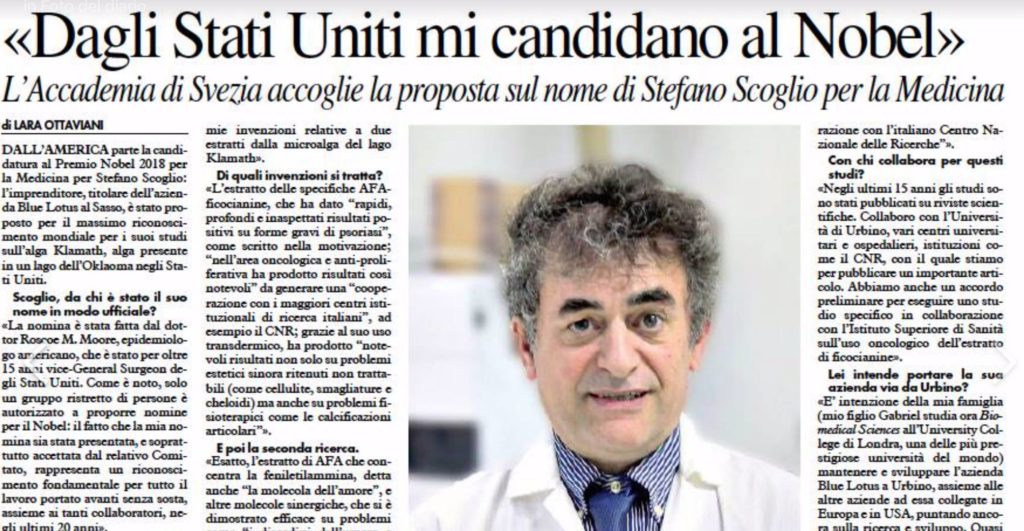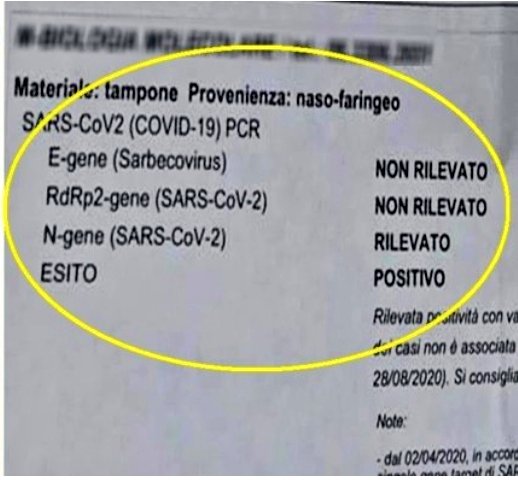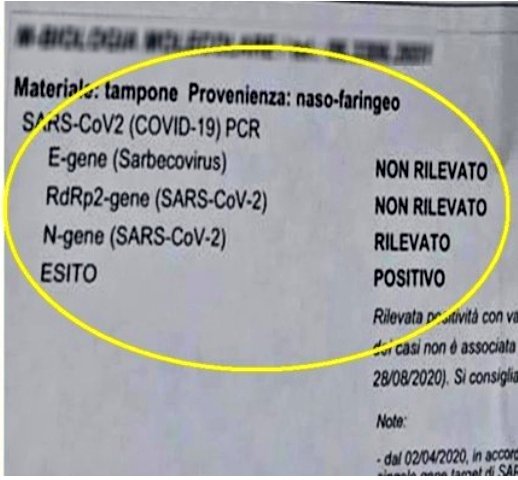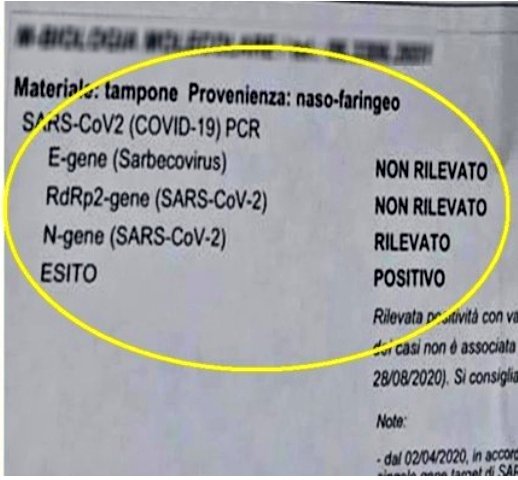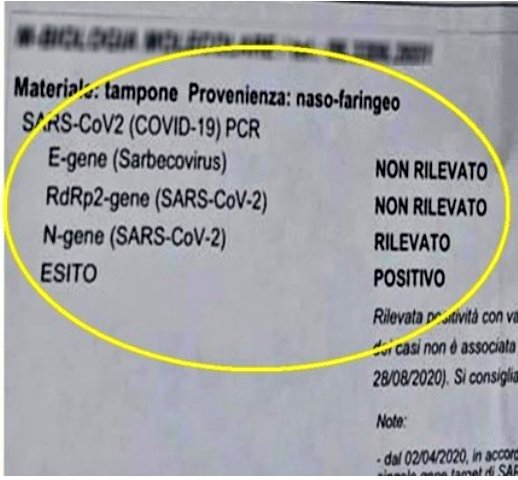ITALY: CONFIRMED BY ITALIAN HEALTH SERVICE: False positives to Covid19 test as diagnosis are 95%. Legal cases started against testing under charges of fraud to procure public funding, false alarm, ideological false, and manslaughter.
ECLUSIVA - AZIONE LEGALE CONTRO I TAMPONI - Parte la prima azione legale con relativa denuncia, intentata da 4 scienziati e un avvocato. https://www.databaseitalia.it/azione-legale-contro-i-tamponi/#.X74Kj1AteAY.twitter">https://www.databaseitalia.it/azione-le... via @databaseitalia
ITALIAN NOBEL PRIZE CANDIDATE 2018 Dr Scoglio explains the Covid19 test fraud, there is more to this than false positives. Thread:
"Today I discovered a new element of this real fraud," Dr Scoglio wrote in a note. It refers to the "choice to reduce the positivity to the swab by detecting only one of the three genes that would define SARS-CoV-2".
Stefano Scoglio: swabs look for 3 genes characterizing SARS-CoV-2: E gene, RdRp gene & N gene. "If the virus were present, all 3 would have to be found, because if the virus is intact, the only case in which it can have a pathogenic role & infect, the test must find all 3 genes"
**In fact, this was initially the case and the results of the swabs were only positive if all three genes were found. But everything has changed since last April.**
The note of this Italian RT-PCR test reads "from 02/04/2020, in agreement with the regional coordinating center, the detection of even a single SARS-CoV-2 target gene is interpreted as a POSITIVE test".
Dr. Scoglio hypothesized that, if the initial criteria for communicating the results of the swabs had been maintained, **we would almost certainly not have detected all the "asymptomatic positives".**
It can also be read in the Italian RT-PCR results: «Detected positive with CT values> 35. It should be remembered that this condition, in more than 95% of cases, is not associated with the presence of infectivity».
Fausto Baldanti, Head of the Molecular Virological Unit at the San Matteo Polyclinic in Pavia study results: "In 400 positives with CT 30 only 9 were able to transmit infections to cell cultures (2.3%)."
"Furthermore, not all genes identified by the swab have the same relevance. The researcher Scoglio pointed out that for example **"the SARS-Cov 2 E-gene is 100% identical to that of SARS-CoV-1"**
Instead, the N gene has only one variation from SARS-CoV-1. "The chances of confusion and cross-reactivity (detecting a SARS virus other than SARS-CoV-2) are very high."
The most relevant in the swab results is the RdRP2 gene with 5 out of 64 variations from SARCoV1. The result changes a lot if this gene is found rather than the other two.
In this specific "POSITIVE", "The only gene detected, as if its non-specificity and cross-reactivity were not enough, was detected with a number of PCR cycles greater than 35, which, according to all serious PCR experts, generates unreliable results , and is generally "junk"..
"At least, in this lab, they wrote that the positive in question is not infectious; but do you think this is reported in the national terrorist statistics?" Dr Stefano Scoglio, Nobel candidate 2018.
This interview aired on Italian national TV Rete 4 in the program Quarta Repubblica conducted by Nicola Porro https://www.mediasetplay.mediaset.it/video/quartarepubblica/la-verita-sui-tamponi_F310595701006C06">https://www.mediasetplay.mediaset.it/video/qua...
A transcript of Scoglio& #39;s comments has been reported in Italian on this site: https://cityfirenze.com/la-truffa-dei-tamponi-il-prof-scoglio-svela-la-falsita-leggete-meglio/">https://cityfirenze.com/la-truffa...
https://twitter.com/robinmonotti/status/1331558731579088902?s=19">https://twitter.com/robinmono...
https://twitter.com/robinmonotti/status/1331559790590513154?s=19">https://twitter.com/robinmono...
Stefano Scoglio& #39;s full statement can be found here: https://www.nogeoingegneria.com/effetti/salute/i-tamponi-covid-19-producono-fino-al-95-di-falsi-positivi-confermato-dallistituto-superiore-di-sanita/">https://www.nogeoingegneria.com/effetti/s...
"The "Drosten PCR Test" & the Institute Pasteur test, considered the most reliable (although neither have been externally validated), both use a test of the E gene, even if the Drosten test uses it as preliminary test, while the Institut Pasteur uses it as a definitive test."
"According to the authors of the Drosten test, the E-gene test is able to detect all Asian viruses, thus being both very non-specific (all viral strains) and limited to a geographical area (Asia)."
"And then in April, WHO has changed the protocol recommending that from now on a test can be considered positive even if only the dosage of gene E (WHICH WILL PROBABLY DETECT ALL ASIAN VIRUSES!) gives a positive result”.
At what cycle thresholds do you effectively create a "ghost virus" out of these gene PCR tests?
GHOST VIRUS: "E gene, which is non-specific and TYPICAL OF ALL CORONAVIRUSES, is around 34-35 cycles; but the average referred to the N2 gene, which should be more specific than SARS-Cov2 (we will see that it is not so even for this gene), is expected to be around 37-38 cycles!"
"All coronaviruses have a nucleus-capsid, and therefore N-type genes. The CDC claims that the N2 gene is specific to SARS-Cov2; but even on this there is no agreement, since for some researchers this is not the case"
"Only one of them (RdRP_SARSr-P2) was almost specific for the new coronavirus and the other introduced gene tests would detect the other types of coronaviruses." (Kakhki RK et al, COVID-19 target: A specific target for novel coronavirus detection, Gene Reports 20 (2020) 100740
"This means that there is no certainty even on the specificity of the N2 gene used by the CDC model, especially if we consider that precisely the N genes are typical of all coronaviruses."
"And when we come to the Drosten test, the European swab test, things become even more evident. First, we see here in an openly stated way, that these virus isolations and definitions are all computer processing, with no physical presence of the virus"
Drosten test: "a diagnostic workflow for detection of an emerging virus in the absence of physical sources of viral genomic nucleic acid." (Corman V et al, Detection of 2019 novel coronavirus (2019-nCoV) by real-time RT-PCR, Euro Surveill. 2020 Jan 23; 25 (3): 2000045, p.10.)
"As can be seen, Drosten& #39;s swab uses all 3 genes, E, N and RdRP. But if we compare the gene sequence of SARS-Cov 2 with that of the original SARS-Cov (at the penultimate place on the list), we see that:
"1. the SARS-Cov 2 gene E is 100% identical to that of SARS-Cov1, and probably to that of all SARS coronaviruses (there are no letter variations in the penultimate line)"
"2. The N gene has only one variation, a C instead of a T, in 15th place in the reverse primer sequence. This is a variation of just 1 / 64th, or just 1.5%. The chances of confusion and cross-reactivity (detecting a SARS virus other than SARS-Cov2) is very high."
"3. The RdRP gene is the only one that has 5 out of 64 variations, again not a big difference, albeit better than the other two (and for this the authors above called it "almost" specific)."
"In short, in total we have a difference of only 6 nucleotides out of 214, a percentage of just 2.8%. And that is why even when independent authors tested the efficiency of the Drosten test they concluded that the test showed:
"... a lot of cross-reactions with Coronavirus BtRs-BetaCoV (MK211374- MK211378), SARS coronavirus Urbani (MK062179-MK062184), Bat coronavirus (KY770858-KY770859), SARS coronavirus (AH013708-AH013709)".
""... high cross-reactivity with Coronaviruses BtRs-BetaCoV (MK211374- MK211378), SARS urban coronaviruses (MK062179-MK062184), Bat coronavirus (KY770858-KY770859), SARS coronavirus (AH013708-AH013709, and others."
RdRP gene "covers many coronavirus isolates, including Bat SARS-like Coronavirus (MG772904-MG772932), Rhinolophus pusillus Coronavirus (KY775091), Bat SARS-like Coronavirus (MG772903) (Kakhki, COVID-19 target: A specific target for novel coronavirus detection, Gene Reports 20"
"In short, all the main test swabs lack specificity, and are affected by a high cross-reactivity, ie they produce a high amount of false positives."
"This truth, which should immediately put an end to the madness of the pseudo-pandemic pushed by these phony tests, is finally, last but not least, openly confirmed by the Istituto Superiore di Sanità itself, a body of the Italian government:
"In the document In Vitro Diagnostic Devices for COVID-19. Part 2: market evolution and information for stakeholders, of 23 May 2020, the Istituto Superiore d Sanità makes an in-depth analysis of the test-swab devices in circulation"
"In this table, taken from the Rapid diagnostic tests for COVID-19 (FIND, Rapid Diagnostic Tests for Covid-19 document: https://www.finddx.org/wp-content/uploads/2020/05/FIND_COVID-19_RDTs_18.05.2020.pdf ) , is">https://www.finddx.org/wp-conten... shown how the ability to correctly identify positives (PPV column) is related to the sensitivity & specificity of the test,
True positive level False positives
2% High performance 49.2% 50.8%
2% Average performance 14.8% 85.2%
2% Low performance 9.3% 90.7%
2% High performance 49.2% 50.8%
2% Average performance 14.8% 85.2%
2% Low performance 9.3% 90.7%
So, at best, swabs give 50% false positives, and at worst they give nearly 91% false positives! On average, we can say that the swabs give 85.2% of false positives!
In all cases, the Istituto Superiore di Sanità certifies that the tampons are completely unreliable!"
In all cases, the Istituto Superiore di Sanità certifies that the tampons are completely unreliable!"
"And here we come to the last consideration. The numbers we have seen refer to the prevalence level of 2%; but in Italy today the level is 0.1%.This means that the range of false positives goes from 50.3 to 75% at best; and about 90.7 to 95% at worst."
https://twitter.com/robinmonotti/status/1331567608961888258?s=19">https://twitter.com/robinmono...
Main sponsors of the Drosten et al. fraudulent PCR testing protocols? WEF & WHO. See thread: https://twitter.com/Bobby_Network/status/1321205508464889862?s=19">https://twitter.com/Bobby_Net...

 Read on Twitter
Read on Twitter